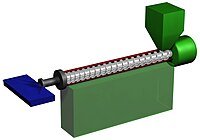
Photo from wikipedia
The back extrusion (BE) method is a well-known translational concentric cylinder viscometry that can analyze viscosity from the force-time curve of a cylindrical plunger pushed into a cylindrical cup filled… Click to show full abstract
The back extrusion (BE) method is a well-known translational concentric cylinder viscometry that can analyze viscosity from the force-time curve of a cylindrical plunger pushed into a cylindrical cup filled with a sample fluid. It can analyze Newtonian, power-law, and Herschel-Bulkley flows. However, the plunger must be moved 100 mm or more from the sample surface toward the cup bottom, any sample fluid adhering to the plunger must be removed. Moreover, given the complexity of the calculation steps, the BE method is not as widely. The short back extrusion (SBE) method proposed in this study is an improved immersed-type BE method. By setting the measurement position inside the sample, the upflow in the annular space is smooth even over a short distance (5-15 mm). Measurement over a short distance decreases the amount of sample adhered to the plunger, mitigating the need to remove any sample from the plunger after each measurement, thereby facilitating repeated measurements. A program automatically determines flow type and, using novel mathematical formulas, it calculates the measured characteristics of the flow. In addition, the greatest advantage of the SBE method is that it can measure samples containing solids. It can be measured in a state in which a person usually eats, because the larger the stress required for the flow, the wider the gap. Moreover, its measurement accuracy is comparable to cone-plate analysis, and the linear region of the analysis area is wide with less destructive movement. This article is protected by copyright. All rights reserved.
Journal Title: Journal of texture studies
Year Published: 2019
Link to full text (if available)
Share on Social Media: Sign Up to like & get
recommendations!